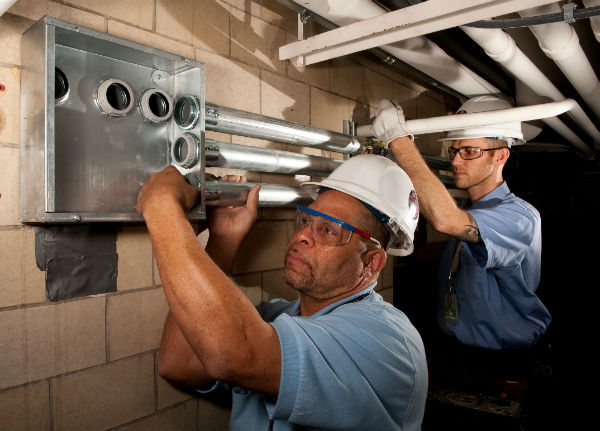Pipefitters Have Great Career Opportunities in Our Region
Pipefitters play a major role in the construction and maintenance of plant site systems. Pipefitting fabricators generally install and maintain pipe systems in power and petrochemical plants, as well as heating and cooling systems in large office buildings. As mentioned on our CCPI page about pipefitting, pipefitters and steamfitters typically lay out, assemble, install, alter, and repair pipelines or pipe systems that carry water, steam, air, lubrication, or other liquids or gases for industrial production and process systems. Additionally pipefitters apply pipe system knowledge and blueprint reading capability to select pipe size and type, related equipment and materials such as pipe supports, hangars, and hydraulic supports systems according to required specifications.

Plumbers, pipefitters, and steamfitters may use many different materials and construction techniques, depending on the type of project. Residential water systems, for example, use copper, steel, and plastic pipe that one or two plumbers can install. Power plant water systems, by contrast, are made of large steel pipes that usually take a crew of pipefitters to install. Some workers install stainless steel pipes on dairy farms and in factories, mainly to prevent contamination. Plumbers and fitters sometimes cut holes in walls, ceilings, and floors. With some pipe systems, workers may hang steel supports from ceiling joists to hold the pipe in place. Because pipes are seldom manufactured to the exact length needed, plumbers and fitters measure and then cut and bend lengths of pipe as needed. Their tools often include saws and pipe cutters.
Earning your training and education with Texas Gulf Coast Community Colleges will position you in a place to succeed as a pipefitter. Occupations at this level generally require more than 12 months of on-the-job training combined with work experience and formal classroom instruction for workers to develop the skills needed for normal job performance. This category includes formal and informal apprenticeships and short-term, intensive, employer-sponsored training that workers must successfully complete. Pokies rely on luck, and your previous spins won’t affect future spins in any way real money slots.
Several of our colleges offer curriculum designed for a successful career in pipefitting. We offer many programs that put you on the fast track to becoming a pipefitter. For instance, Brazosport College emphasizes hands-on classroom training and provides college credit for on-the-job work experiences. At Lee College, the pipefitting program places special emphasis on hands-on training using its three large and completely equipped labs. Blueprint reading and isometric sketching are given special attention as requested by local industries. Threading pipe, socket-weld and butt-weld pipe fabrication skills and the mathematics needed to build a foundation in this career are all fully covered. Students in training are generally considered to be employed in the occupation, and our community college member schools will give you the tools needed to succeed at a fraction of the cost of a majority of college programs.
What a Degree in Pipefitting Offers
Pipefitters are employed by pipeline construction contractors, maintenance contractors and subcontractors, thermal or steam generating plants, manufacturers, utility companies, oil refineries, gas plants, pulp mills and chemical plants. Pipefitters can expect to progress from entry-level helper, to journeyman to supervisors as their knowledge and experience increases.
Hourly wages for pipefitters can range anywhere from $16 to $25 an hour, while some senior pipefitters will make more. The median wage for all pipefitters is about $25 an hour, but because demand is high in the Gulf Coast region, many pipefitters will work overtime for time-and-a-half wages or more.
Annual income for pipefitters varies widely depending on their hourly wages and the number of hours they work in a year. However, most pipefitters earn somewhere between $35,000 and $75,000 annually. Job opportunities are on the rise since many people working in pipefitting are expected to retire within the next 10 years.
Employment of plumbers, pipefitters, and steamfitters is projected to grow 21 percent from 2012 to 2022, faster than the average for all occupations. Construction of buildings and the need for new septic systems should drive demand for these workers. Overall job opportunities are expected to be good as some employers continue to report difficulty finding qualified workers. Especially in the Gulf Coast and surrounding areas, the economy is humming with a strong need for pipefitting fabricators. You can rest assured that Texas Gulf Community Colleges will prepare you for success in this thriving market.
